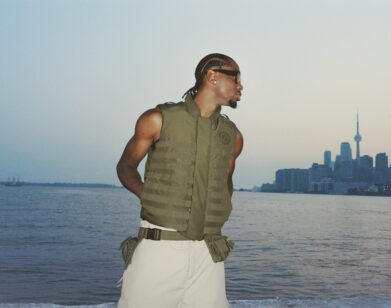Women on the Verge

Ellen von Unwerth and Melvin Sokolsky, two of fashion photography’s most surreal figures, create intense and emotional images that challenge the way we think about beauty and femininity. This weekend, Los Angeles gallery Fahey/Klein opened a dual exhibit presenting photographs from seminal moments in Von Unwerth’s and Sokolsky’s careers.
Her work with the circus and as a model inspired von Unwerth to step behind the camera and translate her experiences into erotically charged, theatrical photographs. “Ellen’s idea of women both embracing their sexuality and their feminine beauty has become her signature style,” says gallery owner David Fahey. “Ellen understands that by simply being a female photographer, she can extract a different kind of erotically charged image.”
Sokolsky first encountered fashion photography as a teenager on the streets of New York, where he’d wander from the Lower East Side to midtown capturing images of high-society women. “I found myself attracted to beautiful upper-class women whose body language and clothes were foreign to me,” Sokolsky explained. Sokolsky’s images weave memorable stories to which scores of photographers have paid homage, most notably the artist’s “Fly” and “Bubble” series for Harper’s Bazaar in the early 1960s. Sokolsky’s whimsical fantasy amounted to models suspended above the River Seine in giant translucent orbs. “Melvin has told us about his encounters with the French police while making these photographs,” Fahey said. Sokolsy’s nonconformity even delighted Diana Vreeland in 1960, who found the artist’s location choice of a ruined tenement provocative and convinced Harper’s Bazaar to publish the photographs, despite an editor’s remark that the average reader would not identify with “a hovel.”
For both artists, the distinctions between fashion photography for editorial, commercial, and artistic ends are largely insignificant. “When you have all the freedom to show what you want, it is art,” von Unwerth says. “For advertising, you have to find the balance between your style and the product. That’s also art in a way, no?”
Sokolsky’s perspective on what constitutes art within fashion photography is even more democratic. “All images are fashion. Even nudes are about fashion,” he said. “I had a student who was looking at a nude I shot and said ‘That’s a ’90s picture.’ I asked how she knew. ‘The way her pubes are trimmed.'” Their inclusive views of the art form, paired with their unflinchingly bold creative decisions, have landed von Unwerth and Sokolsky in the realm of photographic royalty.
The tandem at Fahey/Klein coincides with recent book releases from each. Sokolsky’s Paris 1963/Paris 1965 is an overview of the artist’s most iconic work; the trade edition from Taschen of von Unwerth’s Fraulein (Taschen), a collection of images of the modern era’s sexiest female icons, is also now available.
ELLEN VON UNWERTH’S AND MELVIN SOKOLSKY’S WORK IS AT FAHEY/KLEIN THROUGH NOV. 26.






